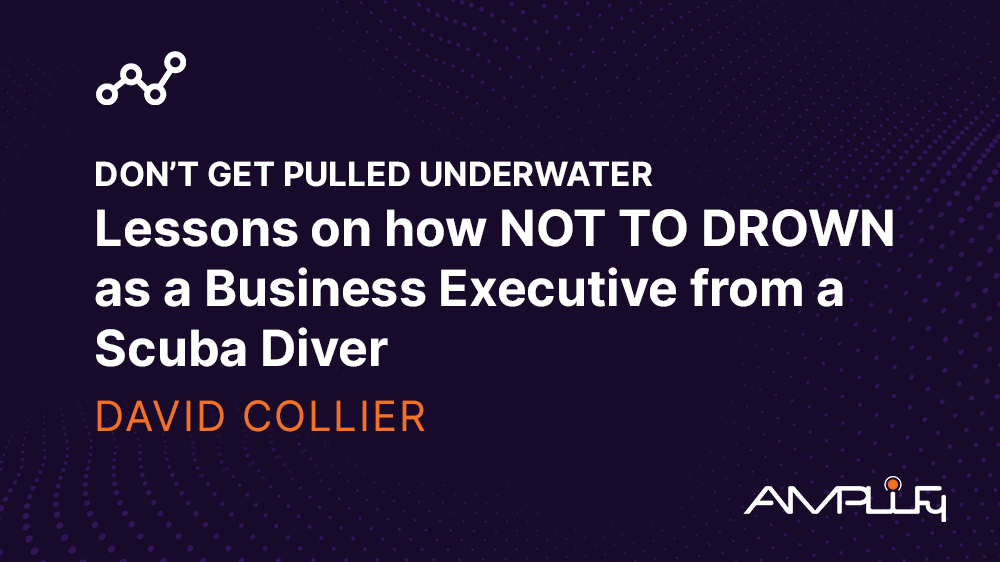Lessons on how NOT TO DROWN as a Business Executive from a Scuba Diver
DON'T GET PULLED UNDERWATER:
Lessons on how NOT TO DROWN as Business Executive from a Scuba Diver
Some of you who know me personally know I have several hobbies and interests that stretch far and wide from my business career. One of these hobbies is Scuba diving. SCUBA, which stands for Self Contained Underwater Breathing Apparatus, was first coined by Dr. Christian Lambertsen in 1954 – a new name for his earlier invention, the Lambertsen Amphibious Respiratory Unit (LARU).
Recently, while studying for an advanced certification, it dawned on me that Scuba, like business leadership, requires precision, awareness, and careful navigation. The mistakes new divers make when learning the ropes in the underwater world mirror the challenges and missteps that executives (new or seasoned) face when they take on a leadership role in a new company. Both require adapting to a new environment, exercising caution, and learning to trust the tools and skills at their disposal.
Here’s a look at the top five mistakes new scuba divers make, and how they equate to the top five mistakes new executives can often make in a new company or role.
1. Poor Buoyancy Control = Struggling to Find Strategic Balance
In diving, poor buoyancy control leads to erratic ascents or descents, making it difficult to maintain stability and harming the environment around you. Similarly, new executives can struggle with balance — caught between immediate demands and long-term strategic goals. Instead of smoothly adjusting to the organization’s culture and current dynamics, they may either push too many changes too quickly or become too passive, failing to gain momentum.
Executive Tip: Master your strategic buoyancy. Align your actions with the company’s immediate needs while ensuring long-term strategies are slowly introduced. Take time to observe, adapt, and balance.
2. Ascending Too Quickly = Moving Too Fast Without Understanding the Environment
Divers who ascend too quickly risk decompression sickness (the bends) — a dangerous and sometimes deadly mistake. In the business world, executives who charge forward with sweeping changes without fully understanding the company’s ecosystem can create confusion, employee disengagement, and resistance to new initiatives.
Executive Tip: Pace yourself. Get to know the organization’s internal structures, key players, and cultural norms before making drastic moves. Rushing transformation without groundwork can lead to long-term damage.
3. Breathing Inefficiently = Failing to Manage Stress and Resources
New divers sometimes breathe too fast or hold their breath, which wastes air and leads to panic. In leadership, executives may get overwhelmed by new responsibilities or spread themselves too thin, reacting to every challenge instead of responding thoughtfully.
Executive Tip: Regulate your leadership “breathing.” Establish a calm, measured approach to decision-making and stress management. Prioritize tasks and resources, taking deep, strategic “breaths” rather than reacting impulsively to every pressure point.
4. Not Equalizing Properly = Failing to Adjust to New Pressures
Just as divers must equalize the pressure in their ears during descent to avoid discomfort or injury, new executives must adjust to new pressures in a business environment. Failing to properly calibrate to the organization’s politics, stakeholders, and market demands can lead to personal and professional strain and in many cases failure.
Executive Tip: Regularly “equalize” by maintaining open communication with key stakeholders. Stay attuned to internal dynamics and adjust your expectations as you descend deeper into the role.
5. Not Monitoring Air Supply = Neglecting Key Resources and Metrics
Running out of air is one of the most fatal mistakes a diver can make. In business, failing to monitor key resources such as cash flow, human capital, or market data can result in disastrous outcomes. Executives sometimes neglect essential business metrics in the rush to prove results, leading to financial instability or operational breakdowns.
Executive Tip: Keep a close eye on your “air supply.” Regularly track key performance indicators (KPIs), financial health, and employee engagement levels to ensure you’re not running out of vital resources at a critical moment.
Final Thoughts
Whether diving into the deep ocean or a new leadership role, the principles of success are strikingly similar: maintaining balance, moving at the right pace, managing stress, adjusting to pressure, and monitoring resources. By taking lessons from the deep sea, new executives can avoid these pitfalls and better prepare for the uncharted waters of leadership.
Just as with diving, preparation and awareness are the keys to a smooth, successful journey in business leadership. Avoid these common mistakes, and you'll be well on your way to becoming a seasoned, successful and confident executive.
See you in the water!!
- David
- PADI Certified Open Water Diver
- PADI Certified Adv Open Water Diver
- PADI Certified Night Diver Specialist
- PADI Certified Equipment Specialist




